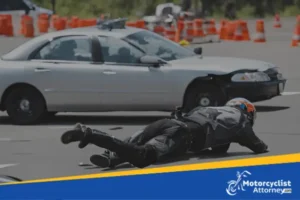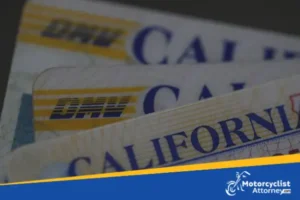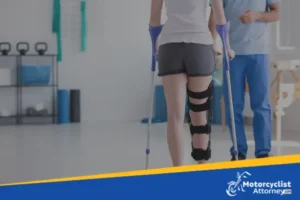
While you enjoy riding a motorcycle with your friends along California’s winding roads, you should always remember to put on the most important safety gear — your motorcycle helmet.
The University of California concluded in their recent study, as published by the National Highway Traffic Safety Administration, that helmeted riders and passengers experience less severe head and neck injuries compared to those who do not wear any type of helmet at all.
Why A Helmet Is Necessary
Motorcycle helmets are beneficial to bike and scooter riders since they reduce the risk of being involved in vehicular accidents. In fact, motorcycle helmet laws mandate wearing the right type of helmet for maximum protection against head injuries in case of an accident. Here are the reasons why no matter what type of riding you do, a helmet should be part of your safety gear:
Motorcycle Helmets do not obscure vision
Studies on helmet use show that less than 3% of peripheral vision is limited by a motorcycle helmet, debunking the misconception that helmets block visibility. Any type of motorcycle helmet, whether half-coverage or full-face helmets, provides a field of vision of more than 210 degrees. This is far above the 140-degree standard that state driver licensing agencies use to identify if there are vision problems and obstructions.
Helmets do not impair hearing
To someone highway riding without a helmet, the sound of the wind and the engines around will be loud. However, important sounds must be louder over all those noises. With a helmet on, the distracting noises can be mitigated, providing extra protection against possible mishaps.
Helmets protect at normal speeds
A study by the University of Southern California found that most motorcycle crashes do not involve a rider crashing head-on into a fixed object. Helmets are tested at a 13.3 mph vertical drop to simulate the types of angle impacts that occur at much higher speeds. Crash data from the US Department of Transportation confirms that helmets are effective in providing protection from head injuries at that speed.
Section 27803 of the California Vehicle Code provides that:
(a) A driver and any passenger shall wear a safety helmet meeting requirements established pursuant to Section 27802 when riding on a motorcycle, motor-driven cycle, or motorized bicycle.
(b) It is unlawful to operate a motorcycle, motor-driven cycle, or motorized bicycle if the driver or any passenger is not wearing a safety helmet as required by subdivision (a).
(c) It is unlawful to ride as a passenger on a motorcycle, motor-driven cycles, or motorized bicycle if the driver or any passenger is not wearing a safety helmet as required by subdivision (a).
(e) For the purposes of this section, “wear a safety helmet” or “wearing a safety helmet” means having a safety helmet meeting the requirements of Section 27802 on the person’s head that is fastened with the helmet straps and that is of a size that fits the wearing person’s head securely without excessive lateral or vertical movement.
Different Types of Motorcycle Helmets
There are different styles of motorcycle helmets that motorcycle riders can use to secure their safety in cases of collision. Here are the most common types used by professional and adventure riders alike.
Full Face Helmets
Full face helmets cover the entire head including the base of the skull to the rear, face, and the chin. Studies have shown that 35% of all crashes show major impact in the chin bar area. The face takes all the damage if there is no protective plastic/carbon/fiberglass. In terms of safety, full-coverage helmets are the safest types you can wear on roadtrips and street riding.
Flip-Up/Modular Helmets
Flip-up/modular helmets have a hinge that allows you to raise, lower, or remove the chin bar. While this type of motorcycle helmet is the second most worn helmet style by commuters, you should still check its safety features. Remember, if safety ratings only exist for the closed position, the manufacturer does not intend for the helmet to be used while open.
Motocross Off-Road Helmets
Motocross is different from any other ride as it’s considered a sport. Riders engaged in this sport should use off-road motocross helmets. The extended chin bar and visor are elongated away from the face, allowing better air circulation and the use of protective goggles for complete protection. The visor provides additional eye protection by shielding the user from the sun and helping to protect the eyes and face from debris.
Open Face Helmets
Open face helmets are open to the front with no chin bar. This type of motorcycle helmet is comfortable and good in places that experience warmer months. In addition, it has a snap-on visor to prevent insects from entering your eyes.
Adventure/Dual-Sport Helmets
Adventure/dual-sport types of helmets are designed to provide a high level of protection for on- and off-riding. Common features include a wider face opening for better peripheral vision which has enough space to wear goggles, a visor for eye protection and to block the sun/debris, and good ventilation to keep the head cool.
Safety Tips on Helmet Use
Protect your head using a motorcycle helmet to avoid traumatic brain injuries that might happen from being in a motorbiking accident. Remember that while there are different motorcycle helmet types, your helmet should fit properly and must be:
- Well taken care of
- Age-appropriate
- Worn consistently and correctly
- Appropriately certified for use
While there is no concussion-proof helmet when you go road riding, a helmet can help protect you from a serious brain or head injury. This is why in wearing any type of helmet you should:
- Make sure that your headis at the upright riding position and not tilted back or forward
- The front of the helmet should be about two finger widths above your eyebrows to protect the forehead.
- The straps on each side of your head should form a letter “Y” over the ears.
- Buckle the chin strap securely at your throat so that the helmet feels snug on your head and doesn’t wiggle up and down or from side to side.
Helmet Care Recommendations
The following must be followed to maintain your helmets and have them always ready to use:
- Handle with care
- Don’t hang your helmet on your mirrors
- Do not use stickers
- Use water only to clean your helmet
- Soften up the bugs
- Avoid furniture polish for cleaning your helmet or visor
- Keep away from fuel
- Store your gloves somewhere safe
- Give your helmet a five-year refresh
- Use the cloth helmet bag wherever you go
Victim of a Motorcycle Crash? Motorcyclist Attorney Will Fight For You!
If you are a victim of a motorcycle crash, what should you do? Call and ask for the assistance of the Motorcyclist Attorney!
We have a team of lawyers who are experts in cases involving injuries among motorcyclists and will guarantee that you’ll get the maximum claim possible. Insurance companies tend to befriend you and then give you lowball offers, but we’re savvier. We know the California laws inside and out and can get you 5x to 7x more compensation for your losses and injuries.
We assure you that you will receive the most appropriate medical treatment and not have to pay a dime unless we win. We work on a contigency fee basis, so you can focus on your recovery while we get back what is due to you from the at-fault party.
Call Motorcyclist Attorney today for immediate attention to your case. Free consultation.




